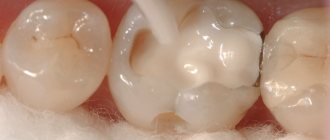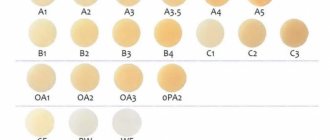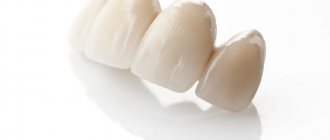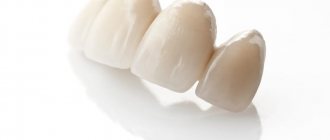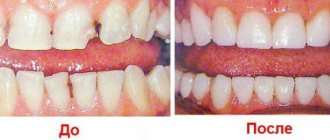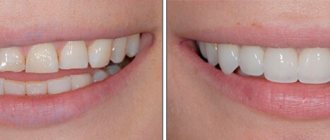A gold crown is a kind of “cover” that is placed on a seriously damaged tooth that is unable to perform its functions. This “cap” helps a person chew food comfortably again without experiencing discomfort or pain. The prosthesis can be made either for one damaged tooth or in the form of a bridge that fills the empty space in place of several missing teeth.
Crowns are made from high-grade gold - 900 gold standard. It is this high-quality metal that is best suited for making a dental “cap”, because it does not oxidize from contact with moisture and is hypoallergenic. At the same time, gold is a fairly durable material that can withstand heavy loads when chewing hard food.
Advantages and disadvantages
The advantages include the following qualities of gold crowns:
- no side effects - high-grade gold does not cause allergies and does not oxidize, therefore, does not stain the surface of the gums and adjacent teeth with plaque;
- lack of taste and smell - the metal is not subject to corrosion and oxidation, therefore, even after a long time it does not change the taste of saliva and food;
- ideal repetition of the tooth shape - gold is a very plastic material that can be easily shaped into a tooth and installed so that the product fits tightly to the gum;
- long service life - if you maintain proper oral hygiene, gold crowns will last at least 15 years;
- similarity to enamel - the “cap” is not capable of harming the general condition of the jaw, because it wears away at the same speed as the surface of the teeth;
- anti-inflammatory properties - the 900 gold case perfectly protects the hidden tooth from caries.
Prostheses made of precious metal have the following disadvantages:
- price - high-grade gold belongs to the upper price category, so not every person can afford such luxury;
- the need to grind down the abutment tooth - in order for the “cap” to fit tightly, the dentist will have to remove part of the enamel and grind the remaining part to fit the internal shape of the crown;
- fashion - many people consider teeth of a distinctive color to be unaesthetic, so they are installed only where they cannot be seen when smiling.
Patient reviews
And I like gold teeth. This has always been considered an indicator of financial importance. I still have dentures from my grandmother; I can take them to a pawnshop. You just need to find out how to clean gold crowns from your teeth and check what kind of gold dental crowns are made of. But I wouldn’t put one on myself, because it’s unfashionable now.
Sergey, St. Petersburg
I am against gold teeth. They look unnatural. But last year I knocked out my front tooth during training. I went to the dental clinic and, as it turned out, not all dentures suit me. The dentist recommended inserting a gold tooth. I doubted it very much, but there were no other options for me. It turns out that they are placed for medical reasons. Especially if there are problems with the kidneys or liver.
In addition, gold dentures last about 15 years. You just need to take proper care of them. I asked what type of dental crowns are used. The doctor explained that gold teeth are of high standard and joked that this is a good investment.
Maxim, Nizhny Novgorod
Several years ago, on the recommendation of a doctor, I had gold teeth installed. It’s good that they are not front, so they don’t interfere with the aesthetics of the look. Gold interacts well with gums and does not cause discoloration. I didn't have any allergic reaction. I know that such teeth do not cause any negative reaction in the body. They are placed if the patient has significant stomach problems. Coated teeth often cause various complications.
However, I think that from time to time it is necessary to take pictures to make sure that everything is in order with the teeth.
It's just for insurance. And so they will serve for at least 10 years, or even more. Marina, Orel
Crown creation technology
To make a suitable prosthesis, the dentist first prepares the teeth - filing and grinding away excess enamel, and then taking an impression of the entire jaw. Casts of the upper and lower dentition become the basis for the production of an accurate plaster model of the client's jaw, which is made in a special laboratory.
Based on the copy, a trial “cap” of wax is created - it is intended to be tried on and, if necessary, to make changes. After fitting and corrections are made to the wax prototype mold, a solid gold crown is made in the laboratory. The surface of the gold dental “case” is ground and polished to get rid of sharp corners that can damage the soft tissues of the oral cavity, and only after that the product is sent to dentistry for subsequent installation.
Use of gold in dentistry
There are two ways to make such crowns: stamped and cast. For stamped ones, special blanks are made. Cast products are cast from gold using wax casts. They do not require any adjustment during installation because they already have a certain size. Cast products are more expensive than stamped ones, but in this case the tooth has to be ground much harder.
Dental crowns from 850 to 900 gold are used. In order for the prosthesis to be stronger, it is made not from pure gold, but with the addition of silver and copper.
How crowns are inserted
Installing dentures is a very painstaking job, because the “cap” should not make you feel discomfort. To get crowns inserted, you will need to visit the dentist several times.
- First visit. During the first visit, the dentist examines the oral cavity for diseases and, if necessary, treats caries or reinstalls worn fillings. If there are no serious problems in the oral cavity that require long-term treatment, the doctor prepares for prosthetics - removes excess enamel and grinds down the tooth, removing up to 1 mm of tissue. Next, he takes impressions of the jaw and creates a plastic onlay that will protect the ground down tooth from damage until a crown is made in the laboratory for permanent use.
- Second visit. After some time, the dentist will invite you to try on a wax prototype of the future gold crown and make adjustments to its shape.
- Third visit. When you visit the dentist for the third time, the doctor will install a ready-made gold “cap” in your mouth, but with a temporary fixation. During this period, the product can be easily removed and adjustments made to its shape if any problems arise.
- Fourth visit. This visit is usually the last in the process of installing gold dentures. 3 months after the third visit, you will need to visit the dentist again to remove the crowns and remove any remaining cement that temporarily attaches the “case” to the jaw. If the prosthesis does not cause discomfort, inflammation or other negative reactions of the body, the doctor firmly attaches it for permanent use.
What are dental veneers price?
Veneers are an orthopedic construction, which are thin, lightweight plates that cover the outer surface of the teeth. ... They perfectly help solve the problem of teeth darkened for various reasons, which cannot be corrected by whitening, adjust the shape and size of the teeth, or eliminate the gap between the teeth.
Interesting materials:
How to activate a memory card on Honor 7a? How to activate a Raiffeisen Bank Aval Ukraine card? How to activate a CityCard card? How do I activate my SPAR card? How to activate the roofing card? How to activate a troika card from your phone? How to activate a Troika card remotely? How to activate a card in Sberbank online after reissue? How to activate a card in Uzcard? How to activate the correct card via SMS?
How to care?
High-grade gold does not require special care or cleaning with expensive products. It is enough to observe standard oral hygiene: brush your teeth with your usual toothpaste in the morning and evening. For additional protection, dentists advise rinsing your mouth after eating with mouthwash or plain water. Also, visit the dentist twice a year to have your teeth examined for diseases, assess the condition of your crowns, and have your mouth professionally cleaned.
Doc 14 Apr 2009
I had a MK bridge on my 4 upper incisors (6 years on temporary cement), they changed it to zirconium. It may be funny to doctors, but from personal feelings it seems that MK crowns are heavier. Not in the sense that it tilts the head forward. I don’t know how to explain correctly. Maybe it’s all a problem in the brain, or the bridge is better quality, but it’s really become easier
I think that if it stood for six years on temporary cement, then everything else in it was consistent with this fact. In addition, cast bridges have shrinkage, and as a result, if they are poorly seated, they can press and cause discomfort. Zirconium is milled and therefore does not give any shrinkage initially. And lastly, a good doctor will not make zirconium crowns into a six-unit bridge. Perhaps you now have them separately? In general, it's not about weight.
How long do they last?
Dental “caps” made of gold are among the most durable dentures - subject to manufacturing technology and proper cleaning of the oral cavity, they can maintain their quality for 12-15 years. But even this period is a minimum, because in most cases gold does not change its appearance and shape even after 20-25 years.
Despite the fact that a crown made of precious metal is durable and can last a very long time, in some cases the doctor may recommend another way to eliminate the problem in the oral cavity. To ensure that prosthetics bring the most effective results, listen to the dentist’s recommendations.
Chieffa 08 Sep 2008
With enviable regularity, doctors hear the same question from patients: “Why, after installing crowns/inlays, does my head steadily pull down?” Or: “Which crowns are heavier: zirconium, metal-ceramic, cast, stamped? Because my teeth/gums are weak....”
The first five times doctors find it funny, then it’s no longer funny, and then they begin to think, “What if it’s really...?”
So, so that patients do not worry in vain, it will be useful for them to know: The average weight of one crown is 1.5 – 3 grams. The weight of the intra-root tab is 1.2 grams.
When chewing, the tooth experiences a load of 30 to 90 kg. So it doesn’t matter to the tooth whether a crown weighing 2 grams or 4 grams is on it!
For those who still feel that the weight acquired after prosthetics is pulling their head down, we can recommend having a haircut like this to move the center of gravity of the skull to its original place (longer at the back, shorter at the front).
Don't let yourself be deceived by a scammer
The most pressing topic, which all experts mostly refuse to talk about, is fraud on the part of jewelers. Of course, the lion's share of goldsmiths work honestly. But only a few of them speak publicly on this issue and give clients advice on how to protect themselves from dishonest colleagues or outright scammers.
When contacting unverified authors, people may encounter these types of scams.
- Substitution of precious stones.
- Dilution of gold composition.
- Conscious increase in the consumption of precious metals in the manufacture of jewelry.
Few people turn to private jewelers to melt down their gold, and therefore word of mouth does not work well in these cases. Not each of us has such acquaintances whose opinion we could safely rely on. Therefore, you will have to contact jewelers at your own peril and risk, testing their honesty experimentally.
To insure yourself against fraud, you need to be extremely careful and require various additional checks. For example, if you brought a gold item to a jeweler inlaid with stones that you want to see in a new piece of jewelry, ask that you record all their characteristics. Carefully inspect the stone yourself and note that there are no chips or scratches on it. If the pebbles are small and there are a lot of them, carefully count the number. When receiving a new gold item, double-check everything carefully.
Rehabilitation period
If the work is performed at the proper level, there will be no need for special adaptation to gold microprostheses, since from the point of view of sensations they do not stand out in the dentition and are almost immediately able to withstand a full chewing load.
You will have to refrain from eating and drinking for several hours after installation. This need is determined by the materials used to secure the prosthesis.
In order to increase the service life and comfortable adaptation to the crown, it is not recommended to eat solid food.
Possible unpleasant consequences of installing crowns:
- Increased tooth sensitivity . Failure to remove the nerve under the treated tooth in advance increases the risk of a reaction to cold, hot, sour, etc. It is necessary for the dentist to prescribe a special toothpaste.
- A crown that is too high can cause pain when chewing . In such a situation, a second visit to the dentist will be required.
- When performing parafunction of the masticatory muscles on a patient, you will need to use a night guard.
- Washing out the cement on which the microprosthesis was fixed . This increases the risk of crown mobility, or its complete destruction, and infections penetrating under the structure. A second visit to a specialist is required to secure the crown more firmly.
Possible problems after prosthetics
Even with high-quality work by doctors and patient compliance with all rules, side effects from prosthetics may occur. They are rare, but the main consequences include:
- Discomfort when eating food. After teeth restoration, it is recommended to refrain from consuming solid foods for 2-3 days: chips, crackers, apples, so that the jaw muscles have time to adapt to the changed chewing load.
- Increased sensitivity of the dentin of the restored unit. The situation occurs after the pulp is removed from the tooth before its preparation. The symptom does not indicate any complications and can be relieved with pastes for sensitive enamel.
Hygiene measures
No special conditions are required to maintain operation. Cleaning is carried out with a toothbrush with soft bristles, sweeping movements in the direction from the gums to the free edge. Plaque on the surface of the alloy practically does not accumulate due to the smoothness of the coating.
You should use floss or dental floss to remove food debris from the interdental spaces. For convenience, you can purchase an irrigator - a device that cleans with a thin stream of water.


